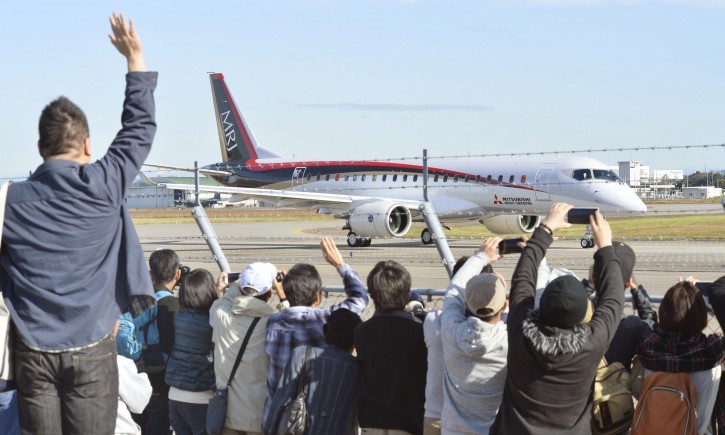
Tokyo – Japan’s first commercial passenger plane in half a century made its maiden flight on Wednesday, in a breakthrough for the country’s long-held ambition to establish an aircraft industry able to challenge some of the major players in global aviation.
The Mitsubishi Regional Jet (MRJ) successfully completed a 1.5-hour return flight from Nagoya Airport to test Mitsubishi Aircraft Corp’s ability to bring the 100-seat class plane into service after three years of delays.
The unit of Mitsubishi Heavy Industries <7011.T>, which built the World War Two-era Zero fighter, is hoping the $47-million regional jet will help it oust Canada’s Bombardier Incas the world’s second-biggest maker of smaller passenger jets behind Brazil’s Embraer SA.
The MRJ turboprop is Japan’s first commercial passenger aircraft since the 64-seat YS-11 turboprop entered service 50 years ago.
The first MRJ is slated for delivery in June 2017 to Japan’s biggest carrier, ANA Holdings <9202.T>. Mitsubishi aims eventually to sell more than 2,000 aircraft in the competitive 70-90-seat mini-segment, currently led by Bombardier.
So far it has secured 223 firm orders, most recently in January when Japan Airlines <9201.T> asked for 32 planes. The biggest single order, for up to 200 aircraft, was from U.S. regional airline group SkyWest Inc.
The flight captured attention as delegates were leaving the Dubai Airshow, where suppliers have been gearing up for new entrants to the jet market such as Japan, China and Russia.
“The biggest regional airline company in the world has ordered 100 of these with 100 options, so it clearly has some appeal,” said Bernie Baldwin, editor of Low-Fare Regional Airlines, an expert on the short-haul jetliner market.
“For me, the thing Mitsubishi have to do now is to get a European customer: that is important,” he told Reuters.
Mitsubishi says the MRJ burns a fifth less fuel than aircraft of similar size, thanks to new-generation engines from Pratt & Whitney, a subsidiary of United Technologies Corp
. Planemakers worldwide are switching to similar engines.
The company said in a statement after the airplane landed that the maiden sortie had confirmed its basic characteristics.
Shares in Mitsubishi Heavy Industries rose as much as 4.4 percent to a 12-week high.
Japan’s last attempt to establish itself as a commercial aircraft maker ended in failure. Production of the YS-11, built by a consortium that included Mitsubishi Heavy, finished after only 182 planes were built.
That program however helped Mitsubishi Heavy and other companies forge ties with Boeing Co
, turning them into major suppliers and partners of the U.S. aircraft maker and helping revive an aerospace industry that was dismantled after World War Two.
Those Japanese companies build 35 percent of Boeing’s advanced 787 carbon-composite jetliner, including the wings, the most complex part.
Japan’s biggest carmaker, Toyota Motor Corp <7203.T>, and largest trading company, Mitsubishi Corp <8058.T>, each own a 10 percent stake in the MRJ venture.
As reported by Vos Iz Neias
